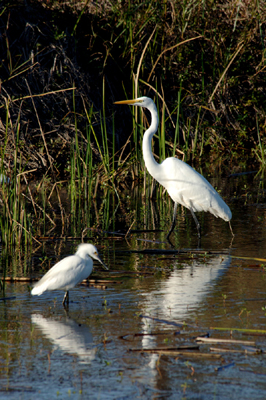Water for Wildlife
Texas is growing - and so are our demands for more water. But where does that leave wildlife? Wildlife need water every day, just like us. Unfortunately, they can't ask for more water; and they can't cut back their need for water to survive.
Wildlife are dependent on naturally occurring water sources. Texas has nearly 200,000 miles of streams and rivers and approximately 1.7
million acres of reservoirs and public water impoundments. These waters provide
habitat for the state’s diverse fish and wildlife species. Scientists recognize
258 fish species that inhabit fresh water for at least a part of their lives.
TPWD estimates that 25 percent of native freshwater fish species are of conservation
concern or already extirpated.
In the 15 major river basins, watercourses range from wide, shallow and sandy
prairie rivers, clear, spring-fed streams, to slow-moving bayous with extensive
hardwood bottomlands. Many of the state’s rivers and streams originate from
Texas freshwater springs. These springs support unique habitats with species
found nowhere else in the world. Both the river and stream systems provide
water for reservoirs, which range in size from less than one acre to the 185,000
acre Toledo Bend Reservoir. In addition, aquifers underlie much of the state
and provide groundwater for people, springs and wildlife. Conserving freshwater begins when it rains and where the raindrops make first contact with the soil.
Texas has 367 miles of coastline along the Gulf of Mexico. The coast is one of the most ecologically complex and biologically diverse regions of the state. It is comprised of nine major bays, from Sabine Lake in the north to the upper and lower Laguna Madre in the south, as well as the Texas Territorial Sea stretching nine nautical miles out from the Gulf beach. More than one-third of Texas’ population and about 70 percent of its industrial base, commerce and jobs are located within 100 miles of the coastline. More than half of the nation’s chemical and petroleum production are located on the coast and the coastal waters support major commercial and recreational fishing industries. Texas leads the nation in marine commerce and the beaches, bays, marshes, prairies and other fish and wildlife habitats of the coast provide numerous recreational opportunities.
Texas’ biodiversity depends on water availability. The state has approximately 6,000 species of plants, and greater than 425 of those species are endemics that occur nowhere else. More than 600 bird species have been identified and 184 known mammals, including marine species that inhabit Texas’ coastal waters. Scientists recognize 258 fish species, 19 of which are considered sportfish, that inhabit fresh water for at least a part of their lives. TPWD estimates that 25 percent of native freshwater fish species are of conservation concern or already extirpated. It is estimated that there are approximately 30,000 insect species in Texas that take up residence in every type of habitat.
Only people can voluntarily alter habits to conserve and protect water. What are the conservation threats to Texas water? [more...]
[top]
|
